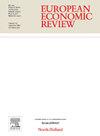Running the risk: Immunity and mobility in response to a pandemic
IF 2.8
2区 经济学
Q1 ECONOMICS
引用次数: 0
Abstract
The relative effectiveness of non-pharmaceutical interventions, such as lockdowns and work-from-home mandates, depends on whether individuals adjust their social behavior in response to infection risk when policy restrictions are absent. Exploiting geographic variation in COVID-19 exposure during the first wave, three key results emerge. First, we find evidence that areas with relatively high excess death rates during the first wave of the pandemic had relatively low excess death rates during the second wave. Second, using granular mobility data from GPS devices, we show that the same areas saw relatively high mobility during the second wave, which may suggest that the first finding is driven by an immunity effect. Finally, the heterogeneity analysis reveals that scarring, behavioral responses, and immunization may operate with varying intensity across municipalities with different age compositions, yielding observable differences in both second-wave mobility and mortality patterns.
冒着风险:应对大流行的免疫力和流动性
非药物干预措施(如封锁和在家工作)的相对有效性取决于在没有政策限制的情况下,个人是否调整其社会行为以应对感染风险。利用第一波疫情期间COVID-19暴露的地理差异,可以得出三个关键结果。首先,我们发现证据表明,在第一波大流行期间超额死亡率相对较高的地区,在第二波大流行期间超额死亡率相对较低。其次,利用来自GPS设备的颗粒流动性数据,我们发现相同的区域在第二波中出现了相对较高的流动性,这可能表明第一次发现是由免疫效应驱动的。最后,异质性分析显示,疤痕、行为反应和免疫接种可能在不同年龄构成的城市中以不同的强度发生作用,从而在第二波流动性和死亡率模式上产生可观察到的差异。
本文章由计算机程序翻译,如有差异,请以英文原文为准。
求助全文
约1分钟内获得全文
求助全文
来源期刊

European Economic Review
ECONOMICS-
CiteScore
4.70
自引率
3.60%
发文量
170
期刊介绍:
The European Economic Review (EER) started publishing in 1969 as the first research journal specifically aiming to contribute to the development and application of economics as a science in Europe. As a broad-based professional and international journal, the EER welcomes submissions of applied and theoretical research papers in all fields of economics. The aim of the EER is to contribute to the development of the science of economics and its applications, as well as to improve communication between academic researchers, teachers and policy makers across the European continent and beyond.
 求助内容:
求助内容: 应助结果提醒方式:
应助结果提醒方式:


